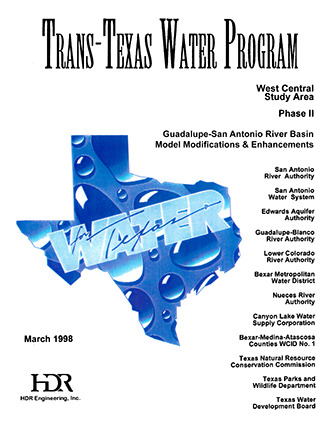Trans-Texas Water Program West Central Study Area Phase II Guadalupe-San Antonio River Basin Model Modifications & Enhancements

| Author | HDR Engineering, Inc, San Antonio River Authority, San Antonio Water System, Edwards Aquifer Authority, Guadalupe-Blanco River Authority, Lower Colorado River Authority, Bexar Metropolitan Water District, Nueces River Authority, Canyon Lake Water Supply |
| Year | 1998 |
| Description | Modifications and enhancements for the Guadalupe-San Antonio River Basin Model (GSA Model) for the Trans-Texas Water Program West Central Study Area Phase II Note: This report is included for its possible historical value but has been replaced by the Texas Water Plan. |
| Publisher | HDR Engineering, Inc |
| Location | Guadalupe-San Antonio River Basin |
| Cover | View Download |
| File | View Download |
| Summary |
|
Note: This report is included for its possible historical value but has been replaced by the Texas Water Plan. The Guadalupe – San Antonio River Basin Model (GSA Model) was originally developed for the Edwards Underground Water District to perform recharge calculations, simulate recharge reservoir operations, and estimate water available for diversion below Comal and San Marcos Springs subject to downstream water rights. Following the development of the original model, significant additional capabilities have been added to the GSA Model to facilitate evaluation of numerous water supply alternatives considered in the Trans-Texas Water Program. Some of these additional capabilities include calculation of: a) Water availability on a monthly timestep at locations throughout the river basin subject to original Trans-Texas Environmental Assessment criteria; b) Canyon Reservoir firm yield using daily inflow sequences for consideration of downstream hydropower and Federal Energy Regulatory Commission (FERC) requirements; c) Water availability subject to alternative environmental criteria for instream flows and freshwater inflows to bays & estuaries which includes reductions of desired flow goals during drought based on moving averages of streamflow; and d) Water availability at selected locations on a daily timestep subject to Environmental Water Needs Criteria from the Consensus Planning Process which also includes reductions of desired flow goals during drought. Hence, the development of the GSA Model is an ongoing, evolutionary process with each new capability of historical streamflow estimates and the channel loss rate function for the Guadalupe River at/above Lake Wood (Hydropower Dam H-5). Enhanced capabilities of the GSA Model include: a) A post-processor program which computes fisheries harvest and salinity estimates for the Guadalupe Estuary; b) Automated simulation of run-of-the-river diversions made firm by storage in Canyon Reservoir; and c) Computation of water available under individual water rights considering priority relative to other rights. Each of these enhancements is described in greater detail in the following sections of the memorandum. Sections which describe enhanced capabilities of the GSA Model also include an example application to illustrate the utility of the new capability necessary to more accurately assess water supply alternatives of particular interest. The GSA Model and database enhancements described in this Technical Memorandum were completed in preparation for technical analyses likely to be required in Phase 2 of the Trans-Texas Water Program and/or other regional planning efforts in the Guadalupe – San Antonio River Basin. Database enhancements completed in the course of this effort include: a) Development of natural daily streamflow sets and statistics representative of the 1934-89 historical period at twenty locations throughout the river basin; and b) Refinement |
Search for Documents
Advance Search
Explore EAA's Scientific Reports
- All Reports
- Modeling
- Hydrology and Hydrogeology
- History
- Groundwater Recharge, Recharge Zone
- Groundwater Movement
- Geomorphology and Caves
- Weather Modification
- Geology
- Water Use and Conservation
- Geochemistry
- Water Resources Planning and Management
- Floods and Drought
- Water Quality
- Climatology
- Surface Water / Groundwater Relationship
- Biology
- Springs, Groundwater Discharge
- Archaeology
- RZ Protection
- Aquifer Levels
- Remote Sensing
- Precipitation
- Overview Studies
